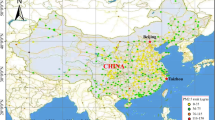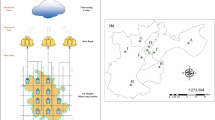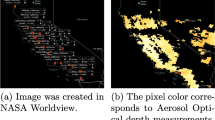Abstract
Exposure to fine particulate matter can easily lead to health issues. PM2.5 concentrations are associated with various spatiotemporal factors, which makes the prediction of PM2.5 concentrations still a challenging task. One of the reasons that makes the accurate prediction by statistical learning method difficult is severe fluctuations in input data. In addition, the abstraction method of space will also affect the prediction results. To address these important issues, a novel hybrid decomposing-ensemble and spatiotemporal attention (DESA) model is proposed to improve the prediction accuracy by decomposing the mode-mixed time series into single-mode series and automatically assign weights to the spatiotemporal factors. In our proposed framework, raw PM2.5 series are firstly decomposed into simple sub-series via the complete ensemble empirical mode decomposition (CEEMD) method. Then, to keep the results independent of the spatial abstraction method, a data-driven approach called multiscale spatiotemporal attention network is employed to extract spatiotemporal features from the sub-series. Finally, the predictions of each sub-series are processed separately and combined to obtain the final prediction results. The experimental results indicate that the proposed model achieved the better performance with RMSE of 11.15, 17.49, 24.84, and 26.93 for 6-, 12-, 24-, and 36-h forecasting, respectively. The proposed method is expected to be applied in fine prediction of air pollution and controlling programs and therefore provide decision support or useful guidance.









Similar content being viewed by others
Data availability
The datasets analyzed during the current study are available in the website of the Environmental Protection Administration (EPA) of China repository, http://www.bjepb.gov.cn/, and the website of the China Meteorological Administration (CMA), http://www.cma.gov.cn/en2014/.
References
Bey I, Jacob DJ, Yantosca RM, Logan JA, Field BD, Fiore AM, Li Q, Liu HY, Mickley LJ, Schultz MG (2001) Global modeling of tropospheric chemistry with assimilated meteorology: model description and evaluation. J Geophys Res Atmos 106:23073–23095. https://doi.org/10.1029/2001JD000807
Byun DW, Ching JKS (1999) Science Algorithms of the EPA Models-3 Community Multiscale Air Quality (CMAQ) modeling system. United States Environmental Protection Agency.
Chen YC, Li DC (2020) Selection of key features for PM2.5 prediction using a wavelet model and RBF-LSTM. Appl Intell 51:2534–2555. https://doi.org/10.1007/s10489-020-02031-5
Eeftens M, Beelen R, De Hoogh K, Bellander T, Cesaroni G, Cirach M, Declercq C, Dedele A, Dons E, De Nazelle A, Dimakopoulou K, Eriksen K, Falq G, Fischer P, Galassi C, Gražulevičiene R, Heinrich J, Hoffmann B, Jerrett M, Hoek G (2012) Development of land use regression models for PM2.5, PM 2.5 absorbance, PM10 and PMcoarse in 20 European study areas; results of the ESCAPE project. Environ Sci Technol 46:11195–11205. https://doi.org/10.1021/es301948k
Fan J, Li Q, Hou J, Feng X, Karimian H, Lin S (2013) A spatiotemporal prediction framework for air pollution based on deep RNN. ISPRS Ann Photogramm Remote Sens Spat Inf Sci 4:15–22. https://doi.org/10.5194/isprs-annals-IV-4-W2-15-2017
Feng X, Li Q, Zhu Y, Hou J, Jin L, Wang J (2015) Artificial neural networks forecasting of PM2.5 pollution using air mass trajectory based geographic model and wavelet transformation. Atmos Environ 107:118–128. https://doi.org/10.1016/j.atmosenv.2015.02.030
Gadi R, Shivani SSK, Mandal TK (2019) Source apportionment and health risk assessment of organic constituents in fine ambient aerosols (PM2.5): A complete year study over National Capital Region of India. Chemosphere 221:583–596. https://doi.org/10.1016/j.chemosphere.2019.01.067
Grell GA, Peckham SE, Schmitz R, McKeen SA, Frost G, Skamarock WC, Eder B (2005) Fully coupled “online” chemistry within the WRF model. Atmos Environ 39:6957–6975. https://doi.org/10.1016/j.atmosenv.2005.04.027
Huang NE, Shen Z, Long SR, Wu MC, Snin HH, Zheng Q, Yen NC, Tung CC, Liu HH (1998) The empirical mode decomposition and the Hubert spectrum for nonlinear and non-stationary time series analysis. Proc R Soc A: Math Phys Eng Sci 454:903–995. https://doi.org/10.1098/rspa.1998.0193
Huang CJ, Kuo PH (2018) A deep cnn-lstm model for particulate matter (PM2.5) forecasting in smart cities. Sensors (Switzerland) 18:2220. https://doi.org/10.3390/s18072220
Jain S, Sharma SK, Vijayan N, Mandal TK (2020) Seasonal characteristics of aerosols (PM2.5 and PM10) and their source apportionment using PMF: A four year study over Delhi, India. Environ Pollut 262:114337. https://doi.org/10.1016/j.envpol.2020.114337
Jin XB, Yang NX, Wang XY, Bai YT, Su TL, Kong JL (2020) Deep hybrid model based on EMD with classification by frequency characteristics for long-term air quality prediction. Mathematics 8:214. https://doi.org/10.3390/math8020214
Karimian H, Li Q, Li C, Jin L, Fan J, Ying L (2016) An improved method for monitoring fine particulate matter mass concentrations via satellite remote sensing. Aerosol Air Qual Res 16(4):1081–1092. https://doi.org/10.4209/aaqr.2015.06.0424
Karimian H, Li Q, Li C, Fan J, Jin L, Gong C, Mo Y, Hou J, Ahmad A (2017) Daily estimation of fine particulate matter mass concentration through satellite based aerosol optical depth. ISPRS Ann Photogramm Remote Sens Spat Inf Sci. https://doi.org/10.5194/isprs-annals-IV-4-W2-175-2017
Karimian H, Li Q, Li C, Gong C, Mo Y, Wu C, Fan J (2019) Spatio-temporal variation of wind influence on distribution of fine particulate matter and its precursor gases. Atmos Pollut Res 10:53–64. https://doi.org/10.1016/j.apr.2018.06.005
Liang Y, Ke S, Zhang J, Yi X, Zheng Y (2018) Geoman: Multi-level attention networks for geo-sensory time series prediction. IJCAI’18: Proceedings of the 27th International Joint Conference on Artificial Intelligence:3428–3434. https://doi.org/10.24963/ijcai.2018/476
Liu H, Chen C (2020) Prediction of outdoor PM2.5 concentrations based on a three-stage hybrid neural network model. Atmos Pollut Res 11:469–481. https://doi.org/10.1016/j.apr.2019.11.019
Mao X, Shen T, Feng X (2017) Prediction of hourly ground-level PM2.5 concentrations 3 days in advance using neural networks with satellite data in eastern China. Atmos Pollut Res 8:1005–1015. https://doi.org/10.1016/j.apr.2017.04.002
Mo Y, Li Q, Karimian H, Zhang S, Kong X, Fang S, Tang B (2021) Daily spatiotemporal prediction of surface ozone at the national level in China: an improvement of CAMS ozone product. Atmos Pollut Res 12:391–402. https://doi.org/10.1016/j.apr.2020.09.020
Mu M, Zhang R (2014) Addressing the issue of fog and haze: a promising perspective from meteorological science and technology. Sci China Earth Sci 57:1–2
Pant HMR (2012) Critical review of receptor modelling for particulate matter: a case study of India. Atmos Environ 49:1–12. https://doi.org/10.1016/j.atmosenv.2011.11.060
Qi Y, Li Q, Karimian H, Liu D (2019) A hybrid model for spatiotemporal forecasting of PM 2.5 based on graph convolutional neural network and long short-term memory. Sci Total Environ 664:1–10. https://doi.org/10.1016/j.scitotenv.2019.01.333
Qiao W, Tian W, Tian Y, Yang Q, Wang Y, Zhang J (2019) The forecasting of PM2.5 using a hybrid model based on wavelet transform and an improved deep learning algorithm. IEEE Access 7:142814–142825. https://doi.org/10.1109/ACCESS.2019.2944755
Shamsoddini A, Aboodi MR, Karami J (2017) Tehran air pollutants prediction based on random forest feature selection method. Int Arch Photogramm Remote Sens Spat Inf Sci - ISPRS Arch. https://doi.org/10.5194/isprs-archives-XLII-4-W4-483-2017
Sharma SK, Mandal TK, Jain S, Saraswati, Sharma A, Saxena M (2016) Source apportionment of PM2.5 in Delhi, India using PMF model.Bull Environ Contam Toxicol 97 (2): 286–293 .https://doi.org/10.1007/s00128-016-1836-1
Shivani GR, Sharma SK, Mandal TK (2019) Seasonal variation, source apportionment and source attributed health risk of fine carbonaceous aerosols over National Capital Region. India Chemosphere 237:124500. https://doi.org/10.1016/j.chemosphere.2019.124500
Torres ME, Colominas MA, Schlotthauer G, Flandrin P (2011) A complete ensemble empirical mode decomposition with adaptive noise. 2011 IEEE International Conference on Acoustics, Speech and Signal Processing (ICASSP). https://doi.org/10.1109/ICASSP.2011.5947265
Wu Z, Huang NE (2009) Ensemble empirical mode decomposition: a noise-assisted data analysis method. Adv Adapt Data Anal 41:1030–1035. https://doi.org/10.1142/S1793536909000047
Wu C, Li Q, Hou J, Karimian H, Chen G (2018) PM2.5 concentration prediction using convolutional neural networks. Sci Surv Mapp 43:68–75
Yeh JR, Shieh JS, Huang NE (2010) Complementary ensemble empirical mode decomposition: a novel noise enhanced data analysis method. Adv Adapt Data Anal 2:135–156. https://doi.org/10.1142/S1793536910000422
Zhang L, Lin J, Qiu R, Hu X, Zhang H, Chen Q, Tan H, Lin D, Wang J (2018) Trend analysis and forecast of PM2.5 in Fuzhou, China using the ARIMA model. Ecol Ind 95:702–710. https://doi.org/10.1016/j.ecolind.2018.08.032
Zhao XJ, Zhao PS, Xu J, Meng W, Pu WW, Dong F, He D, Shi QF (2013) Analysis of a winter regional haze event and its formation mechanism in the north China plain. Atmos Chem Phys 13(1):5685–5696
Zhou Y, Chang FJ, Chang LC, Kao IF, Wang YS, Kang CC (2019) Multi-output support vector machine for regional multi-step-ahead PM2.5 forecasting. Sci Total Environ 651:230–240. https://doi.org/10.1016/j.scitotenv.2018.09.111
Funding
This work is financially supported by the China Postdoctoral Science Foundation [Grant Number 2021M690201] and Jiangxi University of Science and Technology [Grant Number 205200100418]. The fund provides software and hardware funding for research.
Author information
Authors and Affiliations
Contributions
SF analyzed the data and came up with the original model and was a major contributor in writing the manuscript. QL and HK supervised the whole experiment process and proposed modification suggestions. HK and HL put forward a lot of valuable suggestions and gave guidance on the writing of the manuscript. YM gave suggestions on data processing. All authors read and approved the final manuscript.
Corresponding author
Ethics declarations
Ethics approval and consent to participate
Not applicable.
Consent for publication
Not applicable.
Competing interests
The authors declare no competing interests.
Additional information
Responsible Editor: Marcus Schulz
Publisher's note
Springer Nature remains neutral with regard to jurisdictional claims in published maps and institutional affiliations.
Rights and permissions
About this article
Cite this article
Fang, S., Li, Q., Karimian, H. et al. DESA: a novel hybrid decomposing-ensemble and spatiotemporal attention model for PM2.5 forecasting. Environ Sci Pollut Res 29, 54150–54166 (2022). https://doi.org/10.1007/s11356-022-19574-4
Received:
Accepted:
Published:
Issue Date:
DOI: https://doi.org/10.1007/s11356-022-19574-4




